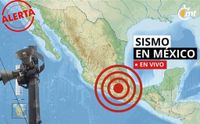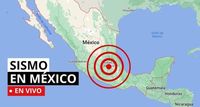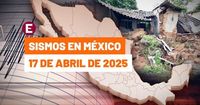Mexico, a nation situated on the Pacific Ring of Fire, continues to experience significant seismic activity, with multiple earthquakes reported on April 17, 2025. The Servicio Sismológico Nacional (SSN) has been diligently monitoring and reporting seismic events across the country, highlighting the importance of preparedness in the face of natural disasters.
On the morning of April 17, the SSN recorded a magnitude 4.1 earthquake at 8:56 AM, located 37 kilometers northeast of San Marcos, Guerrero, at a depth of 39.5 kilometers. Just over an hour earlier, at 8:14 AM, another tremor measuring 4.0 struck 70 kilometers east of Tlacolula, Oaxaca, with a depth of 61.2 kilometers. These seismic events are part of the daily reality for many Mexicans living in a country known for its geological instability.
According to the SSN, the region experiences over 90 earthquakes annually with magnitudes exceeding 4.0 on the Richter scale, accounting for approximately 60% of the world's seismic activity. The states most at risk for significant earthquakes include Jalisco, Colima, Michoacán, Guerrero, Oaxaca, Puebla, Estado de México, and Veracruz. This persistent seismic threat is primarily due to the interaction of various tectonic plates, including the North American Plate, Cocos Plate, Rivera Plate, and Pacific Plate, all of which converge in this geologically active area.
In addition to the more substantial quakes, smaller tremors are a common occurrence. On the same day, the SSN also reported several microsisms, including a magnitude 2.9 event in Pinotepa Nacional, Oaxaca, at 3:51 AM and another similar tremor 40 kilometers west of Técpan, Guerrero, at 3:03 AM. These smaller quakes are often overlooked but contribute to the overall seismic landscape of the region.
Historically, Mexico has faced devastating earthquakes, one of the most catastrophic being the 8.1 magnitude quake that struck Mexico City on September 19, 1985. This disaster resulted in an estimated 10,000 fatalities and widespread destruction of infrastructure. Such events underscore the necessity for robust emergency preparedness measures among the population.
In light of the recent seismic activity, authorities are urging residents to remain vigilant and prepared. The SSN has provided guidelines on what to include in emergency preparedness kits, such as hygiene items, first-aid supplies, non-perishable food, water, and communication devices. These kits are essential for survival in the immediate aftermath of an earthquake.
Moreover, the SSN emphasizes the importance of understanding the difference between various seismic terms. While "sismo" can refer to any seismic movement, the term "terremoto" is often reserved for more destructive quakes. Similarly, "temblor" typically describes lighter quakes that do not cause damage.
As Mexico enters a period of increased seismic activity, particularly during holiday seasons when many travel to coastal areas, the SSN continues to monitor the situation closely. The most common epicenters for earthquakes include the South Pacific Coast, particularly in Guerrero, Oaxaca, Chiapas, Michoacán, and Colima, where the Cocos Plate is subducting beneath the North American Plate. This geological process generates a high frequency of earthquakes.
In urban areas like Mexico City, which is not directly on the fault lines but is affected by quakes from surrounding regions, the impact can be severe due to the soft clay soil that amplifies seismic waves. Residents are encouraged to participate in regular drills and to be familiar with evacuation routes and safety protocols.
In addition to personal preparedness, public transportation systems like the Cablebús and Metro have implemented protocols to ensure passenger safety during seismic events. Passengers are advised to remain calm and listen to instructions from emergency personnel. The Cablebús, for example, is designed to stop safely during an earthquake, and evacuation procedures are in place for any emergencies.
As the nation reflects on its seismic history and the ongoing risks, the SSN remains a crucial resource for real-time information on seismic activity. The organization utilizes a network of sensors distributed across the country to detect tremors and inform the public promptly.
In summary, the recent earthquakes serve as a reminder of Mexico’s geological realities and the importance of preparedness. With the right measures in place, residents can better protect themselves and their families from the impacts of these natural disasters.








